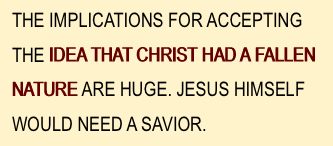ASK THE PASTOR WITH DALE RATZLAFF | Pastor and Founder, Life Assurance Ministries (1936–2024
FIRST PUBLISHED IN THE PRINT VERSION OF PROCLAMATION! MAGAZINE, WINTER, 2014.
As we approach another Christmas season our thoughts turn to the baby Jesus. He was to be the Savior of the world. What kind of nature did that require? Mainstream Christianity holds that Jesus was fully God and fully man. We believe that the human nature of Jesus was completely sinless, patterned after Adam’s nature before the fall. This belief causes us to look to the righteousness of Christ outside of ourselves, that perfect righteousness that is credited to our account on the basis of faith.1 It also means that we, with our fallen natures, filled with the Holy Spirit, will advance in personal righteousness—but our righteousness will never match the holy righteousness of Christ. We can never say we are sinless or that we reflect the image of Jesus fully before we are transformed at the second coming of Christ. However, all the while we can “be ready” for the coming of Jesus.
In our ministry to transitioning Adventists, we must point out that the whole structure of historic Adventism is built on the acceptance of the sinful nature of Christ.2 Historic Adventism believes that the human nature of Christ was patterned after Adam’s human nature after the entrance of sin. Historic Adventists believe Jesus lived the perfect life even though he had a fallen nature identical to all of us. He did this by relying on God’s power and strict self-discipline. Therefore, Adventists would argue that by his death Jesus forgave our past sins, and now we are to follow His example in being an overcomer. The goal for the last generation of Adventists is to “reflect the image of Jesus fully”, a term frequently used by Ellen G. White. It is this last generation that will settle Satan’s charges that God’s law cannot be kept.

Dr. Herbert Douglass, Adventist college administrator, editor, and author, understood the importance of Adventists holding to the belief that Christ had a fallen nature. (All the following quotations come from the same source.)3
The question of the nature of Christ is not a debate over certain theological fine points….Either the cleansing of the sanctuary that began in 1844 is to purify and perfect a people to stand without sin or our denomination is the result of the inability of a group of disoriented fanatics to admit that their prophetic understandings of Daniel were wrong. The real issue is upon the point of overcoming sin. If Jesus could not enter the conflict and overcome in our flesh, then we cannot.
We would agree with Douglass that historic Adventism stands on the fallen human nature of Christ. As he expressed his understanding in articles in Ministry, he, like all who support historic Adventism, turned to the writings of Ellen White for support.
Why Jesus became man…can be understood only from the standpoint of the great controversy—a perspective largely missing in “orthodox” Protestantism as well as in Catholicism….There were several issues, but none more important than Satan’s charge that sons and daughters of Adam could not keep God’s laws, that such laws were unrealistic and not in the best interest of created beings. Such primary issues determined the kind of humanity our Lord would assume in order to satisfy justice and silence Satan (Ministry, Aug., 1985, p. 10-11).
“He knows how strong are the inclinations of the natural heart” (Testimonies, vol. 5, p. 177) Just how does He know this? “He knows by experience…where lies the strength of our temptations.” (Ministry of Healing, p. 71) Without question, Jesus has experienced the strength of the inclinations of the natural heart.
In Gethsemane “His depression and discouragement left Him.” (Desire of Ages, p. 694) Was not Jesus drawn to discouragement by His own thoughts and natural inclinations?
“He had the same nature as the sinner.” (Manuscript Releases, vol. 10, p. 176) The question must be addressed—Was Adam in Eden a sinner? Is a nature partly like Adam and partly like us the same nature as sinners? The reality is that all sinners have fallen natures and are drawn strongly by them.
The implications for accepting the idea that Christ had a fallen nature are huge. Jesus Himself would need a Savior. The only way for us to be saved would be to reach the place where we “reflect the image of Jesus fully.” The historic Adventist “gospel” is not the Christian gospel of God’s abundant grace. †
ENDNOTES
- 2 Cor. 5:21; Rom. 3:21-26; 5:15-21; Eph. 2:16; Phil. 3:6-9.
- 1 Jn. 1:8; Rom. 3:23.
- For an extended discussion of this subject see http://www.dennispriebe.com/new/node/27 subject.
- 18. Jesus, the Law’s Fulfillment - July 10, 2025
- 17.A Better Law - July 3, 2025
- 16. A Better Covenant - June 25, 2025
